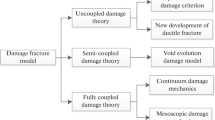Abstract
We propose an approximate semiphenomenological model of the joint process of cold plastic deformation and fracture of metals. Within the framework of this model, for 10kp, 20kp, 20G2R, and 38KhGNM steels, we show that moving dislocations overcome barriers through a force process. The formation of nascent microcracks is also realized through a force process, i.e., local stresses in the “head” of an arrested dislocation pileup attain the levels of theoretical strength. We also suggest a general algorithm of the application of the proposed model to the prediction of fracture of metals in technological processes of plastic metal working.
Similar content being viewed by others
References
A. A. Lebedev, N. G. Chausov, and I. O. Boginich, “A model of accumulation of damage in metallic materials in the complex stressed state,”Probl. Prochn., No. 3, 55–63 (1997).
V. L. Kolmogorov,Mechanics of Plastic Metal Working [in Russian], Metallurgiya, Moscow (1986).
A. A. Bogatov, O. I. Mizhiritskii, and S. V. Smirnov,Plasticity Margin of Metals in the Process of Plastic Working [in Russian], Metallurgiya, Moscow (1984).
V. I. Betekhtin, V. I. Vladimirov, A. G. Kadomtsev, and A. I. Petrov, “Plastic deformation and fracture of crystal bodies. Part 1. Deformation and propagation of microcracks,”Probl. Prochn., No. 7, 38–45 (1979).
B. A. Greenberg and M. A. Ivanov, “On the theory of plastic deformation with an account of dislocation transformations of several types,”Phys. Stat. Sol. (a),45, No. 1, 403–410 (1978).
V. I. Vladimirov,Physical Nature of the Fracture of Metals [in Russian], Metallurgiya, Moscow (1984).
L. E. Popov, V. S. Kobytev, and T. A. Kovalevskaya,Plastic Deformation of Alloys [in Russian], Metallurgiya, Moscow (1984).
F. A. McClintock and A. S. Argon,Mechanical Behavior of Materials, Addison-Wesley, Reading, Mass. (1966).
V. R. Regel’, A. I. Slutsker, and É. E. Tomashevskii,Kinetic Nature of the Strength of Solids [in Russian], Nauka, Moscow (1974).
V. G. Sorokin (ed.),Types of Steels and Alloys [in Russian], Mashinostroenie, Moscow (1988).
I. I. Sidorin, G. F. Kosolapov, V. I. Makarova et al.,Foundations of Materials Science [in Russian], Mashinostroenie, Moscow (1976).
Additional information
Ufa State Aviation Technical University, Ufa, Russia. Translated from Problemy Prochnosti, No. 1, pp. 76–85, January–February, 1999.
Rights and permissions
About this article
Cite this article
Greshnov, V.M., Lavrinenko, Y.A. & Napalkov, A.V. Prediction of the fracture of metals in the processes of cold plastic deformation. Part 1. Approximate model of plastic deformation and fracture of metals. Strength Mater 31, 55–61 (1999). https://doi.org/10.1007/BF02509741
Received:
Issue Date:
DOI: https://doi.org/10.1007/BF02509741



